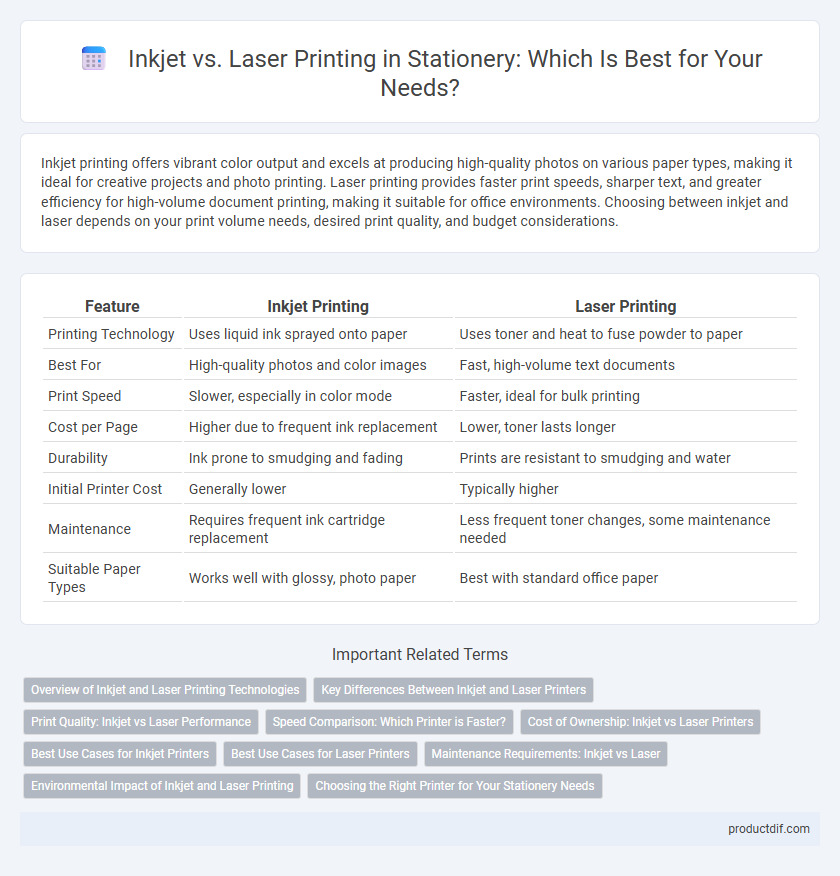Inkjet printing offers vibrant color output and excels at producing high-quality photos on various paper types, making it ideal for creative projects and photo printing. Laser printing provides faster print speeds, sharper text, and greater efficiency for high-volume document printing, making it suitable for office environments. Choosing between inkjet and laser depends on your print volume needs, desired print quality, and budget considerations.
Table of Comparison
| Feature | Inkjet Printing | Laser Printing |
|---|---|---|
| Printing Technology | Uses liquid ink sprayed onto paper | Uses toner and heat to fuse powder to paper |
| Best For | High-quality photos and color images | Fast, high-volume text documents |
| Print Speed | Slower, especially in color mode | Faster, ideal for bulk printing |
| Cost per Page | Higher due to frequent ink replacement | Lower, toner lasts longer |
| Durability | Ink prone to smudging and fading | Prints are resistant to smudging and water |
| Initial Printer Cost | Generally lower | Typically higher |
| Maintenance | Requires frequent ink cartridge replacement | Less frequent toner changes, some maintenance needed |
| Suitable Paper Types | Works well with glossy, photo paper | Best with standard office paper |
Overview of Inkjet and Laser Printing Technologies
Inkjet printing technology deposits tiny droplets of liquid ink directly onto paper, offering vibrant color reproduction and suitability for photos and detailed graphics. Laser printing uses a laser beam to form an electrostatic image on a drum, attracting toner powder to create sharp, fast-drying prints ideal for high-volume text documents. Both technologies serve distinct purposes, with inkjet excelling in color accuracy and laser providing efficiency and durability.
Key Differences Between Inkjet and Laser Printers
Inkjet printers use liquid ink sprayed onto paper, offering superior color blending ideal for photo and graphic printing, while laser printers employ toner and heat to produce sharp text and high-volume black-and-white documents efficiently. Inkjets excel in vibrant color reproduction and lower initial cost, whereas lasers provide faster printing speeds, greater durability, and lower cost per page for extensive usage. Paper handling also differs, with laser printers supporting heavier paper types and larger volumes, making them preferred for office environments.
Print Quality: Inkjet vs Laser Performance
Inkjet printers excel in producing vibrant color gradients and detailed photo-quality images, making them ideal for high-resolution color prints and photographs. Laser printers deliver sharp, crisp text and graphics with consistent clarity, especially suitable for professional documents and bulk black-and-white printing. The choice between inkjet and laser depends on the balance of color accuracy, print sharpness, and printing volume requirements.
Speed Comparison: Which Printer is Faster?
Laser printers typically offer faster printing speeds, reaching up to 40 pages per minute (ppm), compared to inkjet printers which average around 10-15 ppm. This makes laser printers ideal for high-volume printing tasks in office environments where time efficiency is critical. Inkjet printers excel in producing high-quality color prints but generally sacrifice speed for detail and precision.
Cost of Ownership: Inkjet vs Laser Printers
Inkjet printers typically have a lower initial purchase price but higher ongoing ink cartridge costs, making the total cost of ownership higher over time for heavy use. Laser printers generally have a higher upfront cost but offer a lower cost per page due to more efficient toner usage and longer-lasting cartridges. For businesses or individuals with high-volume printing needs, laser printers provide better cost efficiency and reduced maintenance expenses compared to inkjets.
Best Use Cases for Inkjet Printers
Inkjet printers excel in producing high-quality photo prints and detailed graphics, making them ideal for photographers and designers who require vivid color accuracy. They handle various paper types, including glossy and textured media, which enhances creative projects and scrapbooking tasks. Inkjet technology is best suited for low to moderate volume printing where color richness and precision are priorities.
Best Use Cases for Laser Printers
Laser printers excel in high-volume printing environments such as offices and schools due to their fast print speeds and cost-effective toner usage. They are ideal for producing sharp text documents, professional reports, and precise graphics on plain paper. Businesses benefit from laser printing when requiring durable, smudge-resistant prints and consistent quality over large print runs.
Maintenance Requirements: Inkjet vs Laser
Inkjet printers require frequent ink cartridge replacements and regular printhead cleaning to prevent clogging, which can increase maintenance time and costs. Laser printers have toner cartridges that last longer and require less frequent replacement, with occasional drum unit cleaning, resulting in lower overall maintenance demands. Choosing laser printers reduces downtime and simplifies upkeep for high-volume printing environments.
Environmental Impact of Inkjet and Laser Printing
Inkjet printers consume less energy compared to laser printers, resulting in a smaller carbon footprint during operation. However, inkjet cartridges tend to have higher waste generation due to frequent replacement and less recycling infrastructure, while laser printers use toner cartridges that last longer and produce less plastic waste. Overall, selecting environmentally friendly cartridge recycling programs and using energy-efficient models can reduce the environmental impact of both printing technologies.
Choosing the Right Printer for Your Stationery Needs
Inkjet printers excel in producing high-quality, vibrant color prints ideal for detailed stationery designs, while laser printers offer faster output and sharper text, making them suitable for bulk printing of professional documents. Consider inkjet for small-scale, color-rich projects and laser for high-volume, monochrome printing to balance quality with efficiency. Understanding your specific stationery needs ensures the right printer choice, optimizing both cost and print performance.
Inkjet vs Laser Printing Infographic

 productdif.com
productdif.com